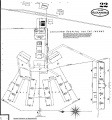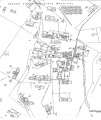Difference between revisions of "Central Louisiana State Hospital"
m |
|||
| (One intermediate revision by one other user not shown) | |||
| Line 23: | Line 23: | ||
==History== | ==History== | ||
| − | In 1902, the Louisiana Legislature created a facility to house and treat the mentally ill. The facility operated under several names since its opening in January 1906, but was later known as Central Louisiana State Hospital. At its peak in 1959, the hospital housed over 3,000 patients, but in recent years, patient numbers at Central dwindled to 246 in 1995 to | + | In 1902, the Louisiana Legislature created a facility to house and treat the mentally ill. The facility operated under several names since its opening in January 1906, but was later known as Central Louisiana State Hospital. The name of Louisiana Hospital for the Insane of Louisiana is changed to Central Louisiana State Hospital in 1924. At its peak in 1959, the hospital housed over 3,000 patients, but in recent years, patient numbers at Central dwindled to 246 in 1995 to 120 being cared for today. The hospital campus is over 400 acres. The hospital grounds also include the Civil War-era Fort Randolph. |
| + | |||
| + | Just one building from a century ago remains, offering a glimpse into a very different version of Central State: the stucco, Renaissance-style Rose Cottage built in 1917. Fittingly, it's become a depository for staff when they find historical photos and items related to Central State, according to administration. The dairy barn (built in 1923) and administration building (built in 1927) are among a few buildings constructed between 75 and 95 years ago. | ||
Today, Central Louisiana State Hospital is a free standing, full service psychiatric hospital licensed by the State of Louisiana, fully accredited by the Joint Commission on the Accreditation of Healthcare Organizations (JCAHO) and certified by the Centers for Medicare/Medicaid Services (CMS). | Today, Central Louisiana State Hospital is a free standing, full service psychiatric hospital licensed by the State of Louisiana, fully accredited by the Joint Commission on the Accreditation of Healthcare Organizations (JCAHO) and certified by the Centers for Medicare/Medicaid Services (CMS). | ||
| Line 66: | Line 68: | ||
</gallery> | </gallery> | ||
| + | [[Category:Louisiana]] | ||
[[Category:Active Institution]] | [[Category:Active Institution]] | ||
[[Category:Cottage Plan]] | [[Category:Cottage Plan]] | ||
| − | |||
[[Category:Institution With A Cemetery]] | [[Category:Institution With A Cemetery]] | ||
Latest revision as of 06:49, 15 March 2021
| Central Louisiana State Hospital | |
|---|---|
 | |
| Established | 1902 |
| Opened | 1906 |
| Current Status | Active |
| Building Style | Cottage Plan |
| Location | Pineville, LA |
| Peak Patient Population | 3,128 in 1959 |
| Alternate Names |
|
History[edit]
In 1902, the Louisiana Legislature created a facility to house and treat the mentally ill. The facility operated under several names since its opening in January 1906, but was later known as Central Louisiana State Hospital. The name of Louisiana Hospital for the Insane of Louisiana is changed to Central Louisiana State Hospital in 1924. At its peak in 1959, the hospital housed over 3,000 patients, but in recent years, patient numbers at Central dwindled to 246 in 1995 to 120 being cared for today. The hospital campus is over 400 acres. The hospital grounds also include the Civil War-era Fort Randolph.
Just one building from a century ago remains, offering a glimpse into a very different version of Central State: the stucco, Renaissance-style Rose Cottage built in 1917. Fittingly, it's become a depository for staff when they find historical photos and items related to Central State, according to administration. The dairy barn (built in 1923) and administration building (built in 1927) are among a few buildings constructed between 75 and 95 years ago.
Today, Central Louisiana State Hospital is a free standing, full service psychiatric hospital licensed by the State of Louisiana, fully accredited by the Joint Commission on the Accreditation of Healthcare Organizations (JCAHO) and certified by the Centers for Medicare/Medicaid Services (CMS).
Plans were announced by the state in February, 2012, to relocate the hospital to a new facility on land adjacent to Pinecrest Supports and Services Center in Pineville. The hospital will retain its name, identity and function to maintain accreditation. The new building will cost $6 million and will be funded through State of Louisiana Capital Outlay funds. Construction will take 12 to 18 months.
Cemetery[edit]
One provision of the original legislation required the hospital board to furnish the legislature at each session a detailed report of the annual receipts and expenditures, a statistical breakdown of new and current enrollment, and a list of those deceased during the previous period. The first superintendent, Dr. George A.B. Hays, immediately set up a morgue and selected a site for a hospital cemetery in order to comply with these requirements.
Given the social conditions of the times, the stigma of mental illness, plus the difficulty of contacting relatives and arranging transportation of the bodies, it was not surprising that many of the deceased patients were buried on the hospital grounds in the cemetery. Until such time as the hospital could obtain the services of a Chaplin, the superintendent or some of the staff physicians handled the burial services, using the simple and beautiful service of the Methodist Church.
These early funeral services were handled entirely by the hospital, with the body being transported to the gravesite in a wheelbarrow until 1933 when a hand-drawn hearse was constructed. This hearse was used until 1950, and was pushed by pallbearers to the gravesite. Deceased female patients were draped in pink or blue shrouds made by the workers in the sewing room, and the carpenter shop probably furnished coffins (although this is not reflected in their individual reports).
Hospital records indicate there are approximately 3,000 people buried in this cemetery, and it was last used in June 1985. A large wooden cross, constructed in the hospital's carpenter shop, was placed on the hill in the early 1960's. A large white solid concrete cross has since replaced it. Hospital workers poured a large concrete slab near the street for the placing of grave markers by relatives of the deceased.




